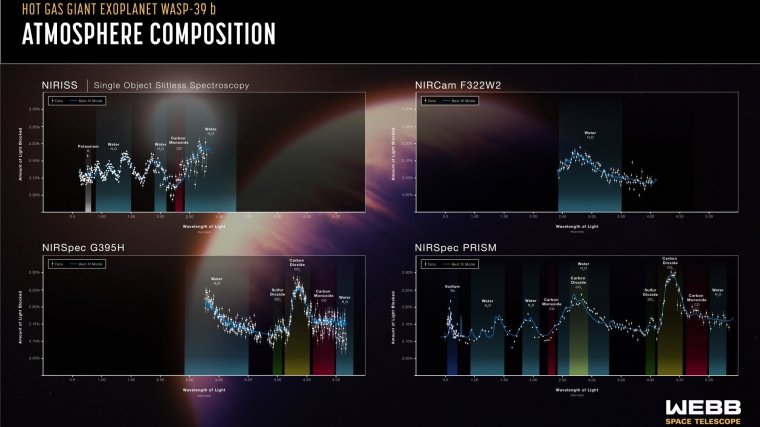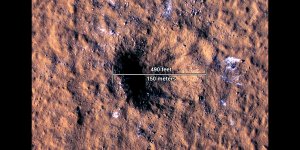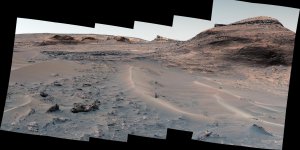| News / Space News |
NASA’s Webb Reveals an Exoplanet Atmosphere as Never Seen Before
NASA’s James Webb Space Telescope just scored another first: a molecular and chemical profile of a distant world’s skies.

The atmospheric composition of the hot gas giant exoplanet WASP-39 b has been revealed by NASA’s James Webb Space Telescope. This graphic shows four transmission spectra from three of Webb’s instruments operated in four instrument modes. At upper left, data from NIRISS shows fingerprints of potassium (K), water (H2O), and carbon monoxide (CO). At upper right, data from NIRCam shows a prominent water signature. At lower left, data from NIRSpec indicates water, sulfur dioxide (SO2), carbon dioxide (CO2), and carbon monoxide (CO). At lower right, additional NIRSpec data reveals all of these molecules as well as sodium (Na). Photo: NASA, ESA, CSA, J. Olmsted (STScI)
While Webb and other space telescopes, including NASA’s Hubble and Spitzer, previously have revealed isolated ingredients of this broiling planet’s atmosphere, the new readings from Webb provide a full menu of atoms, molecules, and even signs of active chemistry and clouds.
The latest data also gives a hint of how these clouds might look up close: broken up rather than a single, uniform blanket over the planet.
The telescope’s array of highly sensitive instruments was trained on the atmosphere of WASP-39 b, a “hot Saturn” (a planet about as massive as Saturn but in an orbit tighter than Mercury) orbiting a star some 700 light-years away.
“We observed the exoplanet with multiple instruments that, together, provide a broad swath of the infrared spectrum and a panoply of chemical fingerprints inaccessible until [this mission],” said Natalie Batalha, an astronomer at the University of California, Santa Cruz, who contributed to and helped coordinate the new research. “Data like these are a game changer.”
The suite of discoveries is detailed in a set of five new scientific papers. Among the unprecedented revelations is the first detection in an exoplanet atmosphere of sulfur dioxide (SO2), a molecule produced from chemical reactions triggered by high-energy light from the planet’s parent star.
On Earth, the protective ozone layer in the upper atmosphere is created in a similar way.
“This is the first time we see concrete evidence of photochemistry – chemical reactions initiated by energetic stellar light – on exoplanets,” said Shang-Min Tsai, a researcher at the University of Oxford in the United Kingdom and lead author of the paper explaining the origin of sulfur dioxide in WASP-39 b’s atmosphere.
“Planets are sculpted and transformed by orbiting within the radiation bath of the host star,” Batalha said. “On Earth, those transformations allow life to thrive.”
The planet’s proximity to its host star – eight times closer than Mercury is to our Sun – also makes it a laboratory for studying the effects of radiation from host stars on exoplanets.
Better knowledge of the star-planet connection should bring a deeper understanding of how these processes affect the diversity of planets observed in the galaxy.
To see light from WASP-39 b, Webb tracked the planet as it passed in front of its star, allowing some of the star’s light to filter through the planet’s atmosphere.
Different types of chemicals in the atmosphere absorb different colors of the starlight spectrum, so the colors that are missing tell astronomers which molecules are present.
By viewing the universe in infrared light, Webb can pick up chemical fingerprints that can’t be detected in visible light.
Other atmospheric constituents detected by the Webb telescope include sodium (Na), potassium (K), and water vapor (H2O), confirming previous space and ground-based telescope observations as well as finding additional fingerprints of water, at these longer wavelengths, that haven’t been seen before.
Webb also saw carbon dioxide (CO2) at higher resolution, providing twice as much data as reported from its previous observations.
Meanwhile, carbon monoxide (CO) was detected, but obvious signatures of both methane (CH4) and hydrogen sulfide (H2S) were absent from the Webb data. If present, these molecules occur at very low levels.
To capture this broad spectrum of WASP-39 b’s atmosphere, an international team numbering in the hundreds independently analyzed data from four of the Webb telescope’s finely calibrated instrument modes.
Having such a complete roster of chemical ingredients in an exoplanet atmosphere also gives scientists a glimpse of the abundance of different elements in relation to each other, such as carbon-to-oxygen or potassium-to-oxygen ratios.
That, in turn, provides insight into how this planet – and perhaps others – formed out of the disk of gas and dust surrounding the parent star in its younger years.
WASP-39 b’s chemical inventory suggests a history of smashups and mergers of smaller bodies called planetesimals to create an eventual goliath of a planet.
“The abundance of sulfur [relative to] hydrogen indicated that the planet presumably experienced significant accretion of planetesimals that can deliver [these ingredients] to the atmosphere,” said Kazumasa Ohno, a UC Santa Cruz exoplanet researcher who worked on Webb data.
“The data also indicates that the oxygen is a lot more abundant than the carbon in the atmosphere. This potentially indicates that WASP-39 b originally formed far away from the central star.” (NASA)
YOU MAY ALSO LIKE





